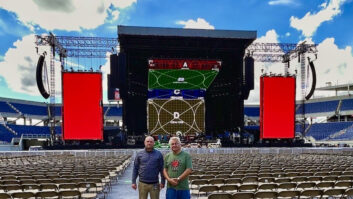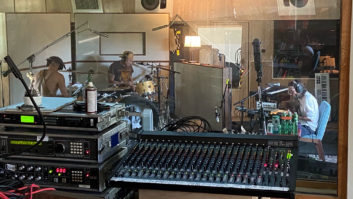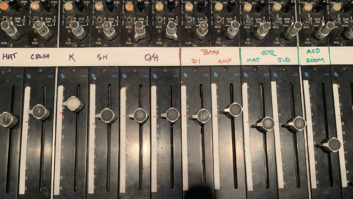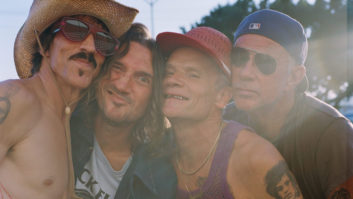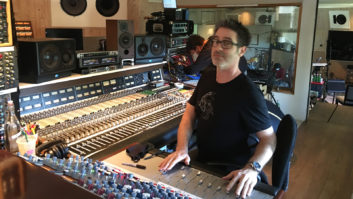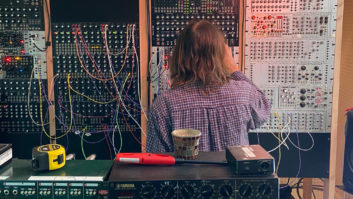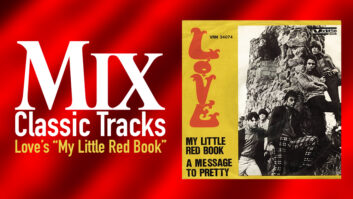Is it that now-classic 200-track train wreck in The Fugitive? The gun battle denouement of L.A. Confidential? Squeaking bats juxtaposed against a roaring Batmobile in Batman Forever? A Time To Kill‘s buzzing mosquitoes and slithering snakes? Or maybe those screaming, souped-up race cars in The Fast and the Furious? Pinning down the definitive SoundStorm scene is a tough call. The independent company’s sonic artists create designs that run the gamut from spectacular to subtle, the common thread being that these guys go the whole nine yards — and more — on every movie.
SoundStorm’s slogan is “Out of Our Minds and Into Your Ears,” and there may be more truth in that than even those who coined it intended. Longtime SoundStorm supervising sound editors Bruce Stambler and John Leveque, who have garnered, between them, five Academy Award nominations and one win (Stambler, for Ghost and the Darkness), are known for going to extremes. They’ve used ropes to drag a manned dumpster over concrete and dirt, slogged through bat guano in a Puerto Rican cave, paddled canoes through the swamps of a Louisiana bayou, and recorded 124 DATs of race-car sounds out in the Mojave. And that’s for just four of the over 60 films that, separately and together, they’ve worked on.
Heavy stuff, but in an era dominated by consolidation and merger, the greatest challenge SoundStorm’s principals face just might be staying independent. In the post industry, as in the rest of the business world, the trend has been toward the creation of technical and corporate behemoths, capable — theoretically — of marshalling vast resources in an efficient and cost-effective manner. While the end results of such consolidation remain to be seen, no one doubts that staying independent and competitive is a tough task. Three years ago, in a move reminiscent of the creation, back in 1919, of United Artists by screen luminaries Charlie Chaplin, Douglas Fairbanks and Mary Pickford, six sound professionals attacked that tough task, joining together to purchase SoundStorm and chart their own destiny.
SoundStorm, which started out 18 years ago in Hollywood as Walla Works Productions, has survived numerous transitions; several members of “The SoundStorm Six” have survived those transitions as well. Still, running a company with six owners has to be its own kind of tough task. What seems to make the process work at SoundStorm is a special kind of camaraderie that stems from the principals’ shared experiences in the industry.
“Out of our six partners, four are sound editors,” explains VP John Switzer, who came onboard in September 2000 from SoundDogs, where he was also a VP. “Bruce Stambler, John Leveque and Rich Yawn are supervising sound editors, and Becky Sullivan is a supervising ADR editor — tops in her field. Having people who are in the trenches running the company gives us a tremendous edge. It’s not like having an investment banker or an accountant making decisions that don’t apply to the real world of post-production. And, because of our smaller size, we can react quickly when we need to. It’s not like an aircraft carrier where you turn the wheel and an hour later the ship turns.”
In addition to the four sound editors, SoundStorm’s partners include president John Fanaris and technical specialist Gary Blufer, who runs the company’s busy transfer department. Depending on the workload, the overall staff expands and contracts from its core of 15 to about 60, with approximately 10 sound supervisors in house at any one time.
“The ownership situation is unique, of course, in having this many partners,” continues Switzer. “But what’s great is that things are not necessarily designed by committee. Because of their knowledge and experience, everybody is able to run their area in a very autonomous fashion.”
Becky Sullivan, just off Domestic Disturbance where she served as supervising ADR editor, concurs. “This is my 80th feature,” she comments. “And I’ve done most of them with John [Leveque] or Bruce [Stambler]. That means there’s no ramp-up time when we start a project — we understand each other’s style of working and what needs to be done. Also, we’ve worked on multiple projects with so many directors and producers that we know how they like to work. That makes things go faster and easier.”
With ownership in place, SoundStorm went about enlarging its talent pool. Last summer, they purchased EFX Post and formed an informal working relationship with Wilshire Stages. Two years ago, they recruited supervising sound editor Alan Murray, who brought with him a string of high-profile credits including Lethal Weapon 1 & 2, Fried Green Tomatoes, Bridges of Madison County, Unforgiven and Laura Croft, Tomb Raider. Although Murray, who has accumulated four Academy Award nominations, including one in 2000 for Best Sound Editing on Space Cowboys, has put in stints running sound departments for major studios, he’s spent most of his career as an independent. At SoundStorm, he feels like he’s found the best of both worlds.
“It’s a melding of two worlds,” he explains. “I’m not behind studio walls, but I’m with a group that I respect. We have diverse backgrounds and different ideas, but we have a common goal and that’s to do a great job. You get different ideas by talking to different people, but you’re not involved in their daily work all the time. It’s nice to work that way.
“The big conglomerates often tend to take on too much,” he continues. “Being independent, we still have to fight budgets, but we can choose to work with people who care about their sound and are willing to give us the means to do the job we know how to do. We work with people who care, and who really want to make their movie special.”
While SoundStorm’s editors are often found on location or on dubbing stages all over town, much of the work is done at their own facility, which encompasses two buildings on Glenwood Place in Burbank’s Media District. The complex is a busy warren of edit suites and offices, including a 5.1 mix studio; on one day in mid-October, the rooms were cranking on a number of projects, including Domestic Disturbance, Officer Involved, Queen of the Damned, The Guru and 24 Hours. The complex is fitted with Pro Tools, Avid and Fairlight systems, and courtesy of the transfer operation helmed by Blufer, almost every other imaginable format.
Eighteen years of recording new and authentic sound effects for each project has resulted in a legendary in-house effects library, estimated to consist of over 200,000 sounds, including unique backgrounds from across the United States and in Japan, Puerto Rico and Mexico, as well as particularly extensive vehicle and aircraft recordings. Over the past summer, in conjunction with mSoft, SoundStorm began digitizing all original effects (from DAT and ¼-inch) and loading them into a customized ServerSound system. Doug Bossi handled the implementation for SoundStorm, while mSoft’s Amnon Sarig wrote code to provide a “notepad” style of effects spotting. By job’s end, the server will hold up to a terabyte of material.
Meanwhile, SoundStorm librarians are also in the process of transferring the library to .AIFF files stored on an HTML-based server. The value of such a resource is obvious, and SoundStorm has recently entered into a collaboration with Andrew Sunnucks and Robert Hurst, formerly with British music company Boosey & Hawkes, to create AudioNetwork plc, an online subscription music and effects service scheduled to debut in early 2002.
“SoundStorm’s library is unparalleled in its depth and quality, and this is the first time anyone outside will have access to it,” notes Switzer. “AudioNetwork’s music side will consist of all original material, from top composers. What we’re offering is a convenient way for professionals to search for and acquire extremely high-quality sound effects and music.”
Many of SoundStorm’s clients, producers and directors, like Philip Noyce, Rob Cohen, Peter MacGregor-Scott and Andy Davis, have a special affinity for quality sound. It was SoundStorm’s work with Davis on the Steven Seagal vehicle Under Siege that garnered the company its first Academy Award nomination and first real accolades.
“It really was the most important thing in our company’s history,” notes Stambler. “It gave us a chance to do a sound-intensive movie that was, for its time, quite unique and very cool. It put us on the map. And, almost everybody associated with it went on to Fugitive. That was an awesome opportunity, because Fugitive was a great movie without sound. We just happened to get really lucky — Peter MacGregor-Scott said, ‘Do whatever you want — make it great!’ And we went as far out as we could on a sound level. From Fugitive we got Clear and Present Danger because the director saw it and wanted us. It platforms, I think, as long as you keep proving yourself, stepping up to the plate, and doing the right thing by the filmmaker and everyone else associated with the studio. Because, basically, in this business, it’s about relationships.”
“That’s true,” agrees Switzer. “With so many established supervising sound editors, we have a tremendous depth of relationships with directors, picture editors and producers. That’s where we get work. And it makes it incumbent upon us to do a great job, because a business like this is really built upon return clients. We always want to make sure the filmmaker is happy.”
